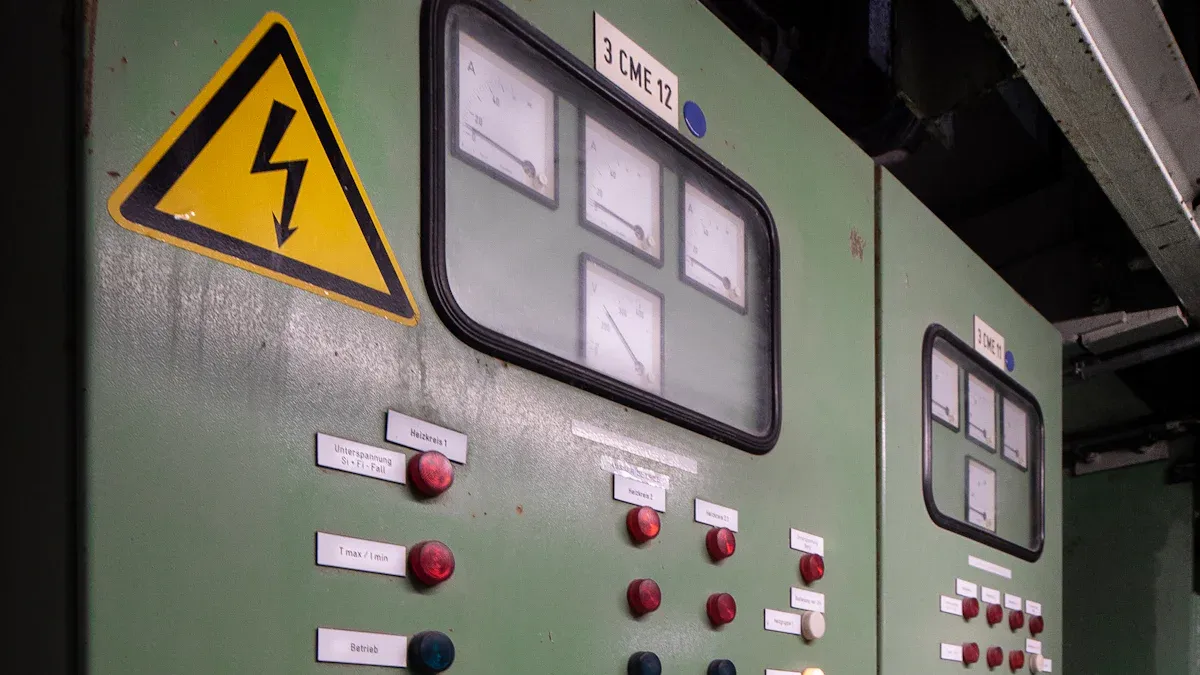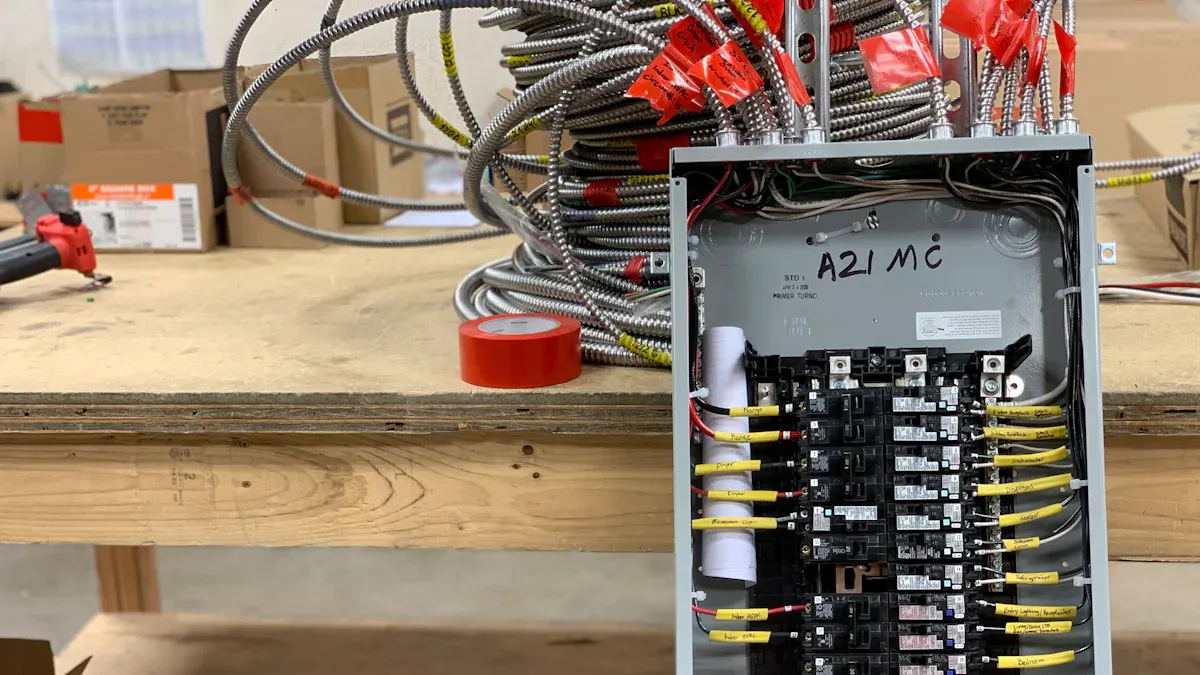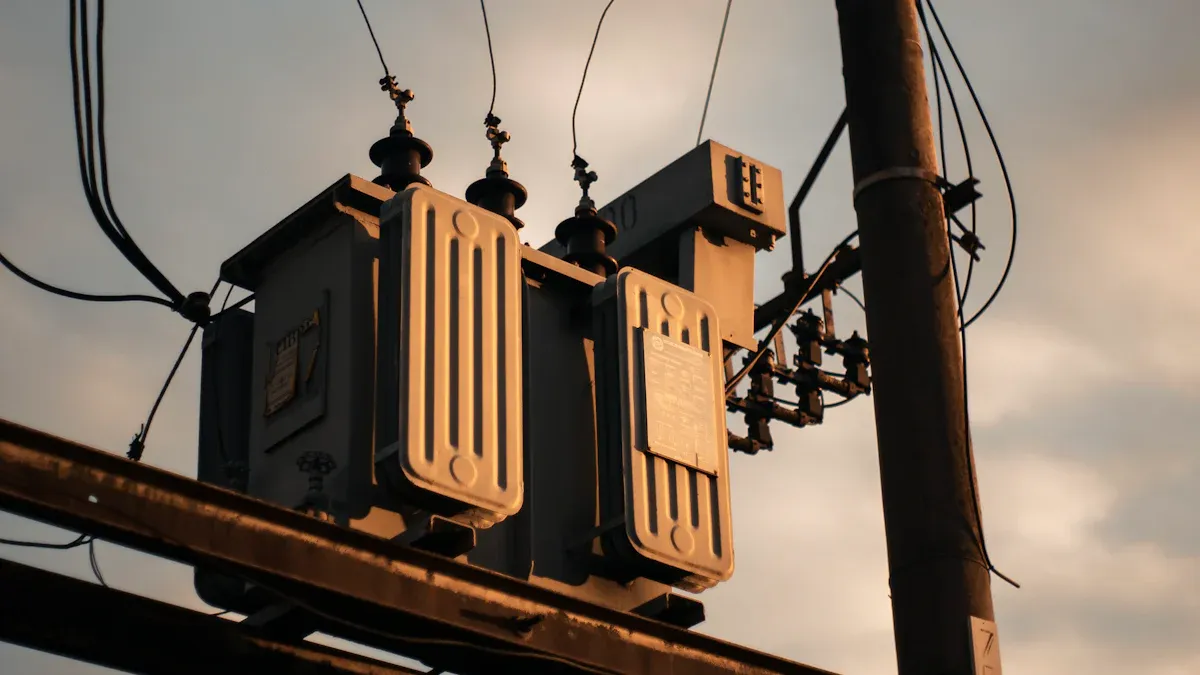What Is an Electrical Distribution Box and Why Is It Important

An electrical distribution box is the main control for power. It sends electricity from the main source to different circuits. This ensures each part of your building gets power it needs. Its main job is to keep your electrical system safe and working well. It stops overloads and separates problems to avoid dangers.
This box gives steady power and keeps your system safe. It is very important for control and efficiency. It is a key part of modern electrical systems.
Key Takeaways
An electrical distribution box spreads power safely to circuits in a building. It stops overloads and keeps the system working well.
Checking and maintaining your distribution box often is important. This finds problems early, keeps it safe, and makes it last longer.
Always hire a licensed electrician for setup and inspections. Experts follow safety rules and lower the chance of electrical dangers.
Knowing parts of the box, like breakers and grounding, improves safety. These parts stop problems and protect from electrical risks.
Picking the right distribution box—home, business, or factory—keeps your system safe and working its best.
Components of an Electrical Distribution Box

An electrical distribution box has important parts that work together. These parts help share power safely and efficiently. Each one has a job to keep the system reliable. Let’s look at these parts more closely.
Circuit breakers
Circuit breakers are the most important part of the box. They stop electricity flow when there’s a problem, like an overload. This protects your devices and prevents electrical fires.
Think of a circuit breaker as a safety switch. It shuts off power automatically if something goes wrong. Testing them often is important to make sure they work in emergencies. Studies also check how well they work with other safety devices, making the system safer.
Tip: Have a professional check your breaker panel regularly to keep it working well.
Bus bars
Bus bars are metal strips that send power to circuits. They act like a hub, helping electricity flow to different areas.
Copper bus bars are strong and conduct electricity well, so they’re used a lot. Aluminum bus bars are lighter and cheaper, good for saving money. In factories, bus bars power big machines and control panels. They handle high currents and tough conditions, keeping connections steady.
Note: How long a bus bar lasts depends on its material and care. Copper ones can last many years if maintained properly.
Enclosure and housing
The enclosure, or case, keeps the box’s parts safe from dust, water, and damage. It protects both the system and people nearby.
Good enclosures are made from strong materials and meet safety rules. Some have IP ratings, showing how much protection they give. For example, an IP67-rated case blocks dust and can handle water for a short time. Drip-tight cases stop moisture and help parts last longer.
When picking an enclosure, think about where it will go and the conditions it will face. A good case not only keeps things safe but also helps the system work better.
Grounding systems and terminal blocks
Grounding systems and terminal blocks are key parts of an electrical distribution box. They help keep your system safe and working properly. Knowing what they do shows why they are so important.
Grounding Systems
A grounding system gives electricity a safe way to flow into the ground. This happens during problems like faults, stopping shocks or fires. Without grounding, stray electricity could hurt people or damage devices.
Here’s why grounding systems are important for safety:
Protecting Against Electrical Hazards
Studies show even small currents can be dangerous. For example:Just 1 milliamp can make muscles move without control.
At 50 milliamps, workers face serious risks.
Charles Dalziel found 91 milliamps could cause deadly heart problems.
Handling Faults and Lightning
Grounding systems control power surges from faults or lightning. A safe path to the ground lets these surges fade away. This protects devices and lowers fire risks.
Tip: Hire a professional to install and check your grounding system. This ensures it meets safety rules and works well.
Terminal Blocks
Terminal blocks are spots inside the box where wires connect. They keep wires neat and secure, making the system easier to handle. These blocks also stop loose wires from causing problems.
Here’s how terminal blocks help your system:
Simplified Wiring
Terminal blocks organize wires neatly. This makes fixing problems during repairs much easier.Enhanced Safety
Tight wires in terminal blocks stay in place. This lowers the chance of faults or short circuits.Durability
Good terminal blocks resist heat and rust. This helps them last longer and work well in tough conditions.
Note: Check your terminal blocks often for damage or wear. Replacing bad ones quickly avoids bigger issues.
Grounding systems and terminal blocks may seem small, but they are very important. They help keep your electrical system safe and running smoothly. Knowing their value ensures your box works well for a long time.
Functions of an Electrical Distribution Box
An electrical distribution box is very important for your building. It helps manage and protect your electrical system. It makes sure power is shared safely and works well. Let’s look at its main jobs.
Power distribution to circuits
The main job of the box is sharing power. It takes electricity from the main source and splits it into smaller circuits. Each circuit powers a specific area or device. This keeps the system from overloading.
For example, one circuit might power your kitchen, and another your lights. If one circuit has a problem, the others still work. The box also has safety devices like breakers and fuses. These stop power during problems to keep things safe.
Did You Know? These boxes stop overloads that can cause fires. They are used in homes, offices, and factories to share power safely.
Circuit protection and overload prevention
Another important job is protecting circuits. The box has breakers and fuses to stop overloads and short circuits. These devices cut off power when something goes wrong. This protects your devices and prevents fires.
Modern boxes have extra safety features like surge protection. These features make the system safer and more reliable.
Feature/Function | What It Does |
|---|---|
Safety and Protection | Keeps electrical connections safe and prevents accidents. |
Smart Technology | Lets you control and check the system remotely. |
Includes surge protection and other tools for better safety. |
Tip: Check your electrical box often to ensure safety devices work. This can save money and prevent problems.
Isolation of electrical faults
The box also stops problems from spreading. If there’s a fault, the breaker for that circuit shuts off. This keeps the rest of the system working.
For example, if your living room circuit has a problem, only that circuit stops. Other areas like the kitchen or bedroom stay on. This makes it easier to find and fix the issue.
By stopping faults from spreading, the box keeps your system safe and efficient. It helps power return quickly and reduces downtime. This makes it a key part of modern electrical systems.
Note: Always call a licensed electrician for repairs. Broken breakers or wires can make your system unsafe.
Improving System Efficiency and Control
An electrical distribution box helps your power system work better. It is the main hub that sends electricity to different circuits. This keeps power flowing smoothly and makes the system reliable.
It improves efficiency by letting you check power levels in real time. Modern boxes show voltage and current as they happen. This helps you spot problems early and fix them quickly. For example, if a circuit uses too much power, you can fix it before damage occurs.
Remote monitoring makes controlling the system easier. You can watch your power system from anywhere using smart devices. This is helpful for businesses to manage power and avoid downtime. Real-time data also helps you make smart choices to keep the system running well.
Advanced tools like wide-area monitoring systems (WAMS) make the system even better. These tools help fix big problems fast and keep the grid stable. Adding these features makes the box a strong tool for managing power.
Circuit breakers in the box also protect the system. They shut off power to a circuit if there’s a problem. This stops damage and keeps the rest of the system working. This feature saves your devices and lowers repair costs.
Types of Electrical Distribution Boxes

Electrical distribution boxes come in different types for various uses. Knowing these types helps you pick the best one for your needs.
Residential Distribution Boxes
Residential boxes are made for homes. They safely send power to areas like kitchens and bedrooms. These boxes are small and simple to set up, perfect for tight spaces.
Inside, circuit breakers stop power during overloads or short circuits. This keeps your family and devices safe from harm.
Tip: When upgrading your home’s system, check the box meets safety rules.
Commercial Distribution Boxes
Commercial boxes are used in offices, stores, and business spaces. They handle more power than residential boxes. They send electricity to lights, HVAC systems, and office tools.
These boxes often have surge protection to guard devices like computers. They are also easy to fix, reducing downtime during repairs.
Feature | Benefit |
|---|---|
Surge Protection | Shields delicate equipment |
Modular Design | Makes upgrades and fixes easier |
Note: Check your commercial box often to avoid costly problems.
Industrial Distribution Boxes
Industrial boxes are for factories and warehouses. They manage high-voltage power for machines and production lines.
These boxes are tough and built to last. They can handle extreme heat, cold, and vibrations. Some are waterproof or dustproof for harsh conditions.
Did You Know? Industrial boxes can be customized for specific needs.
Picking the right box keeps your system safe and working well, whether at home, work, or in a factory.
Specialized boxes, like waterproof or outdoor distribution boxes
Specialized electrical distribution boxes are made for tough environments. These boxes shield your system from bad weather, water, and dust. They are crucial for outdoor areas or places with harsh conditions.
What Makes Them Special?
Waterproof and outdoor boxes have unique features. Here’s what makes them different:
Weatherproof Build: They are sealed to block rain, snow, and moisture.
Strong Materials: Made from stainless steel, aluminum, or sturdy plastic to stop rust.
IP Ratings: These boxes often have IP ratings. For example, an IP65 box blocks dust and handles water sprays.
Tip: Check the IP rating before buying. It shows how well the box handles specific conditions.
Where Are They Found?
These boxes are used in many outdoor and industrial places:
Home Yards: They power garden lights, fountains, or outdoor kitchens.
Business Areas: Used for parking lot lights or security cameras.
Factory Sites: Needed for outdoor machines and equipment.
Why Are They Useful?
These boxes keep your system safe and working in hard conditions. Without them, water or dirt could cause damage or short circuits.
Did You Know? Some outdoor boxes have UV protection to stop sun damage. This makes them great for sunny areas.
Picking the right box protects your system and saves money on repairs. Always ask a professional to install it correctly and follow safety rules.
Installation Requirements and Safety Compliance
Proper placement and accessibility
Putting your electrical distribution box in the right spot is important. It should be easy to reach for repairs or emergencies. Do not place it in wet, very hot, or risky areas. A dry and airy spot helps it work well and last longer.
For homes, basements, garages, or utility rooms are good choices. In offices or factories, place it where it can be checked easily. Make sure it is mounted at a height you can reach without tools or ladders.
Tip: Keep the space around the box clear for quick access in emergencies.
Adherence to electrical codes and standards
Following safety rules is very important when setting up the box. These rules make sure your system is safe and works properly. Inspections are key to meeting these rules. Early checks look at wiring before walls cover it. Final checks ensure everything is safe and follows the rules.
Important documents include:
Inspection papers
Completion certificates
Permits
Material records
Maintenance logs
These papers prove your setup meets safety rules. Picking the right box size and features is also important. Circuit breakers and fuses stop power during problems, preventing fires or overheating.
Note: Regular checks and fixes help your system stay safe over time.
Importance of professional installation
Hiring a licensed electrician is the safest way to install the box. Experts know the safety rules and can handle tricky setups. They also pick the right box based on size, strength, and safety needs.
A professional setup lowers the chance of mistakes that cause problems or dangers. They also place the box in a safe, easy-to-reach spot with good airflow. Paying for expert help protects your property and keeps your system working well for years.
Did You Know? Bad installations are a top cause of electrical fires. A pro can help you avoid this danger.
Regular maintenance and inspections
Taking care of your electrical distribution box is very important. Regular checks keep it safe and working well. Fixing small problems early stops big, costly issues later.
Why Maintenance Matters
Skipping maintenance can cause big troubles like fires or breakdowns. Checking your system often helps avoid these dangers. It also makes your wiring and panels last longer. Regular care keeps your system safe by spotting problems early.
Regular care keeps your system safe and reliable.
Inspections find worn-out parts before they cause trouble.
Taking care of your system helps it last longer.
Benefits of Condition Monitoring
Condition monitoring is a smart way to check your system. It finds up to 70% more problems early compared to regular checks. This method saves money on repairs and lowers downtime by 45%. For example, in places needing steady temperatures, power loss can cause big problems. Monitoring helps stop these issues before they happen.
Tip: Plan regular checks and use condition monitoring to avoid problems.
Keeping Records
Keeping notes about repairs and checks is very helpful. These notes show how your system is doing over time. They also help you follow safety rules and plan future fixes or upgrades.
By checking your system often, you save money, protect your property, and keep your electrical system running well.
An electrical distribution box is very important for power systems. It safely shares electricity and protects circuits from problems. This box helps you control your system and keeps it reliable. Regular checks and care make sure it works well. Having a professional install it keeps it safe and follows the rules. Taking care of your box prevents dangers and makes it last longer. A good distribution box protects your property and keeps power running smoothly.
FAQ
What does an electrical distribution box do?
An electrical distribution box sends power from the main source to circuits. It keeps power flowing safely and protects against overloads or faults.
Tip: Think of it as the "brain" of your building's power system.
How often should you check an electrical distribution box?
You should check your electrical distribution box once every year. Regular checks find damage or risks early, keeping your system safe and working well.
Note: Always hire a licensed electrician for a complete inspection.
Can you set up an electrical distribution box yourself?
No, you should not set it up yourself. Only professionals can install it safely and follow the rules to avoid fires or failures.
Did You Know? Many electrical accidents happen because of bad installations.
What are the warning signs of a bad electrical distribution box?
Watch for these warning signs:
Circuit breakers trip often
Burning smells near the box
Strange buzzing sounds
Rust or visible damage
Warning: Call an electrician right away if you see these signs.
Are there different kinds of electrical distribution boxes?
Yes, there are types for homes, businesses, factories, and outdoor use. Each type is made for specific places and power needs.
Example: Waterproof boxes are great for outdoor lights or garden tools.
See Also
Choosing the Ideal Outdoor Electrical Cabinet for Your Requirements
Understanding Outdoor Enclosure Cabinets and Their Advantages
Exploring ESTEL PDUs and Their Importance in Data Centers
Outdoor Communication Cabinets: Their Uses and Applications Explained
CALL US DIRECTLY
86-13752765943
3A-8, SHUIWAN 1979 SQUARE (PHASE II), NO.111, TAIZI ROAD,SHUIWAN COMMUNITY, ZHAOSHANG STREET, NANSHAN DISTRICT, SHENZHEN, GUANGDONG, CHINA

